Procurement Plan and Scope of Work: Cleaning Contract, Semester 2
VerifiedAdded on 2021/04/16
|13
|4233
|96
Report
AI Summary
This report provides a comprehensive procurement plan for a cleaning contract, specifically targeting a 5-story office building in the Perth Central Business District (CBD). It outlines the personal vision statement, procurement needs, and a detailed market analysis, including competitor identification and financial considerations such as budget, financing methods, and pricing structures. The report explores various procurement methods, including open procedures, restricted procedures, and competitive dialogue, alongside the importance of sustainable practices. It also covers risk management, contract types, external factors impacting the industry (technology, customer research, and marketing), and the contract approval process. The scope of work section details the building's specifications, assumptions, objectives, and responsibilities. The report also includes a communication management plan, contractor deliverables, and key activities, providing a complete overview of the cleaning contract procurement process, including scored selection criteria and project timelines.
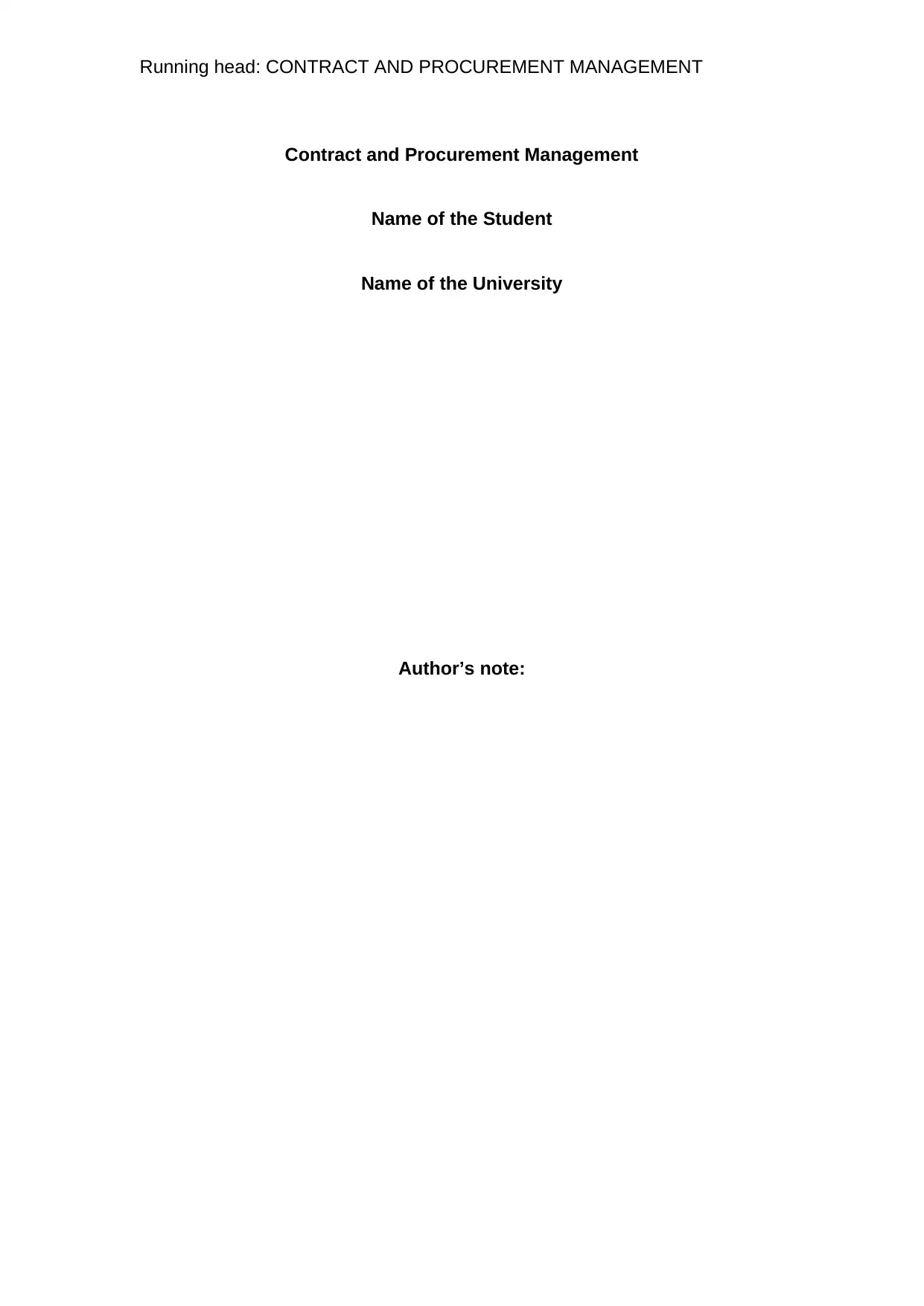
Running head: CONTRACT AND PROCUREMENT MANAGEMENT
Contract and Procurement Management
Name of the Student
Name of the University
Author’s note:
Contract and Procurement Management
Name of the Student
Name of the University
Author’s note:
Paraphrase This Document
Need a fresh take? Get an instant paraphrase of this document with our AI Paraphraser
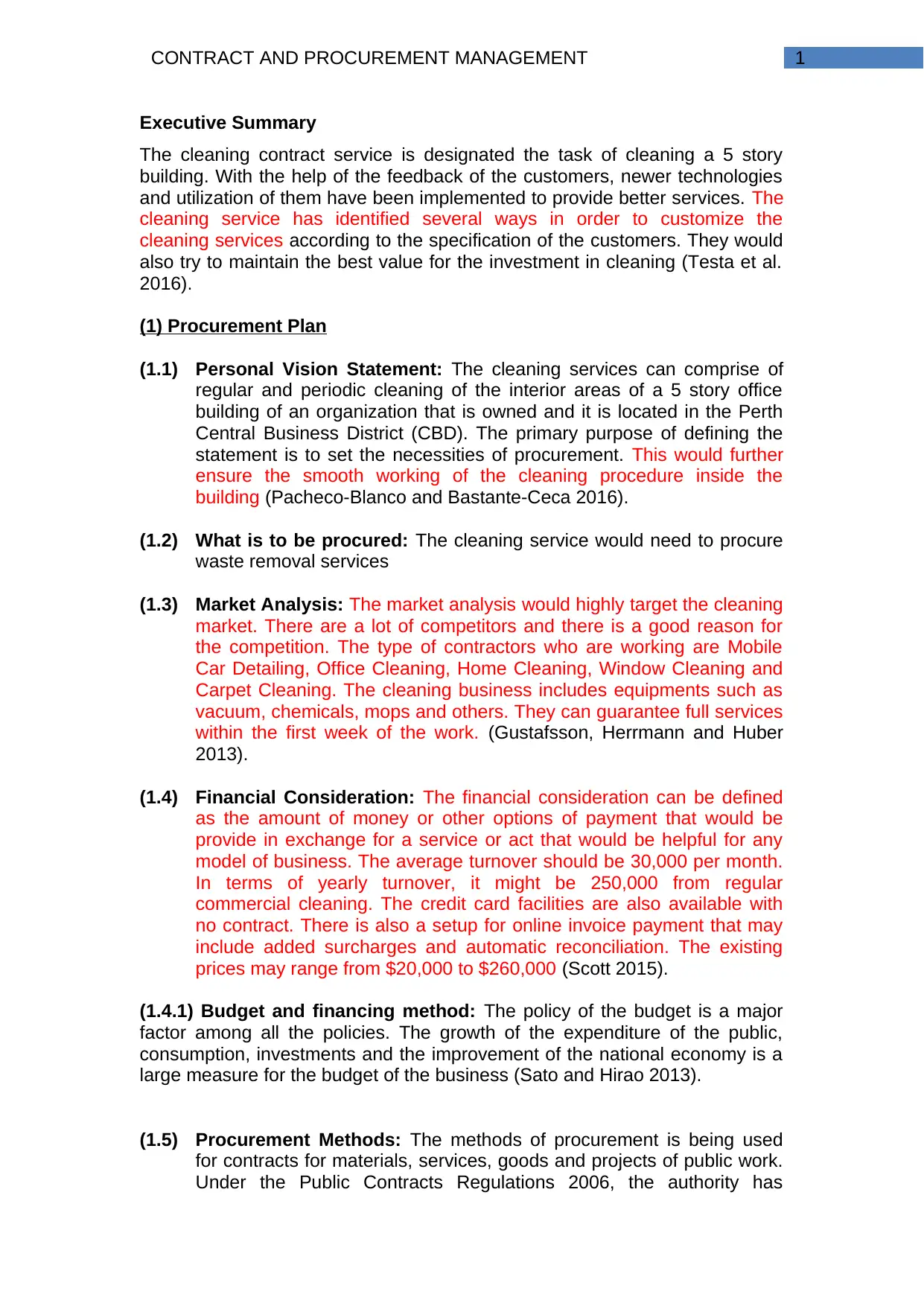
1CONTRACT AND PROCUREMENT MANAGEMENT
Executive Summary
The cleaning contract service is designated the task of cleaning a 5 story
building. With the help of the feedback of the customers, newer technologies
and utilization of them have been implemented to provide better services. The
cleaning service has identified several ways in order to customize the
cleaning services according to the specification of the customers. They would
also try to maintain the best value for the investment in cleaning (Testa et al.
2016).
(1) Procurement Plan
(1.1) Personal Vision Statement: The cleaning services can comprise of
regular and periodic cleaning of the interior areas of a 5 story office
building of an organization that is owned and it is located in the Perth
Central Business District (CBD). The primary purpose of defining the
statement is to set the necessities of procurement. This would further
ensure the smooth working of the cleaning procedure inside the
building (Pacheco-Blanco and Bastante-Ceca 2016).
(1.2) What is to be procured: The cleaning service would need to procure
waste removal services
(1.3) Market Analysis: The market analysis would highly target the cleaning
market. There are a lot of competitors and there is a good reason for
the competition. The type of contractors who are working are Mobile
Car Detailing, Office Cleaning, Home Cleaning, Window Cleaning and
Carpet Cleaning. The cleaning business includes equipments such as
vacuum, chemicals, mops and others. They can guarantee full services
within the first week of the work. (Gustafsson, Herrmann and Huber
2013).
(1.4) Financial Consideration: The financial consideration can be defined
as the amount of money or other options of payment that would be
provide in exchange for a service or act that would be helpful for any
model of business. The average turnover should be 30,000 per month.
In terms of yearly turnover, it might be 250,000 from regular
commercial cleaning. The credit card facilities are also available with
no contract. There is also a setup for online invoice payment that may
include added surcharges and automatic reconciliation. The existing
prices may range from $20,000 to $260,000 (Scott 2015).
(1.4.1) Budget and financing method: The policy of the budget is a major
factor among all the policies. The growth of the expenditure of the public,
consumption, investments and the improvement of the national economy is a
large measure for the budget of the business (Sato and Hirao 2013).
(1.5) Procurement Methods: The methods of procurement is being used
for contracts for materials, services, goods and projects of public work.
Under the Public Contracts Regulations 2006, the authority has
Executive Summary
The cleaning contract service is designated the task of cleaning a 5 story
building. With the help of the feedback of the customers, newer technologies
and utilization of them have been implemented to provide better services. The
cleaning service has identified several ways in order to customize the
cleaning services according to the specification of the customers. They would
also try to maintain the best value for the investment in cleaning (Testa et al.
2016).
(1) Procurement Plan
(1.1) Personal Vision Statement: The cleaning services can comprise of
regular and periodic cleaning of the interior areas of a 5 story office
building of an organization that is owned and it is located in the Perth
Central Business District (CBD). The primary purpose of defining the
statement is to set the necessities of procurement. This would further
ensure the smooth working of the cleaning procedure inside the
building (Pacheco-Blanco and Bastante-Ceca 2016).
(1.2) What is to be procured: The cleaning service would need to procure
waste removal services
(1.3) Market Analysis: The market analysis would highly target the cleaning
market. There are a lot of competitors and there is a good reason for
the competition. The type of contractors who are working are Mobile
Car Detailing, Office Cleaning, Home Cleaning, Window Cleaning and
Carpet Cleaning. The cleaning business includes equipments such as
vacuum, chemicals, mops and others. They can guarantee full services
within the first week of the work. (Gustafsson, Herrmann and Huber
2013).
(1.4) Financial Consideration: The financial consideration can be defined
as the amount of money or other options of payment that would be
provide in exchange for a service or act that would be helpful for any
model of business. The average turnover should be 30,000 per month.
In terms of yearly turnover, it might be 250,000 from regular
commercial cleaning. The credit card facilities are also available with
no contract. There is also a setup for online invoice payment that may
include added surcharges and automatic reconciliation. The existing
prices may range from $20,000 to $260,000 (Scott 2015).
(1.4.1) Budget and financing method: The policy of the budget is a major
factor among all the policies. The growth of the expenditure of the public,
consumption, investments and the improvement of the national economy is a
large measure for the budget of the business (Sato and Hirao 2013).
(1.5) Procurement Methods: The methods of procurement is being used
for contracts for materials, services, goods and projects of public work.
Under the Public Contracts Regulations 2006, the authority has
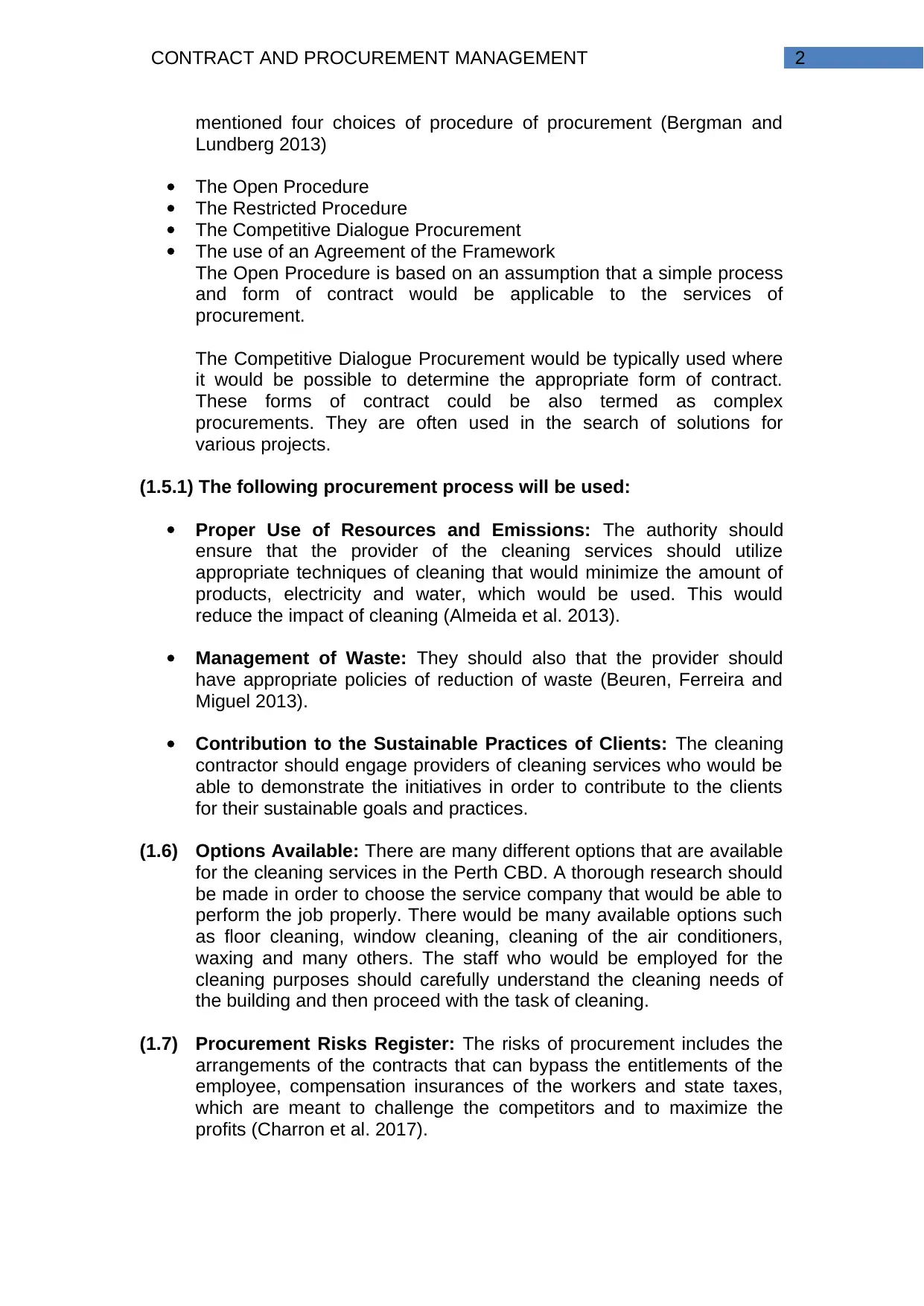
2CONTRACT AND PROCUREMENT MANAGEMENT
mentioned four choices of procedure of procurement (Bergman and
Lundberg 2013)
The Open Procedure
The Restricted Procedure
The Competitive Dialogue Procurement
The use of an Agreement of the Framework
The Open Procedure is based on an assumption that a simple process
and form of contract would be applicable to the services of
procurement.
The Competitive Dialogue Procurement would be typically used where
it would be possible to determine the appropriate form of contract.
These forms of contract could be also termed as complex
procurements. They are often used in the search of solutions for
various projects.
(1.5.1) The following procurement process will be used:
Proper Use of Resources and Emissions: The authority should
ensure that the provider of the cleaning services should utilize
appropriate techniques of cleaning that would minimize the amount of
products, electricity and water, which would be used. This would
reduce the impact of cleaning (Almeida et al. 2013).
Management of Waste: They should also that the provider should
have appropriate policies of reduction of waste (Beuren, Ferreira and
Miguel 2013).
Contribution to the Sustainable Practices of Clients: The cleaning
contractor should engage providers of cleaning services who would be
able to demonstrate the initiatives in order to contribute to the clients
for their sustainable goals and practices.
(1.6) Options Available: There are many different options that are available
for the cleaning services in the Perth CBD. A thorough research should
be made in order to choose the service company that would be able to
perform the job properly. There would be many available options such
as floor cleaning, window cleaning, cleaning of the air conditioners,
waxing and many others. The staff who would be employed for the
cleaning purposes should carefully understand the cleaning needs of
the building and then proceed with the task of cleaning.
(1.7) Procurement Risks Register: The risks of procurement includes the
arrangements of the contracts that can bypass the entitlements of the
employee, compensation insurances of the workers and state taxes,
which are meant to challenge the competitors and to maximize the
profits (Charron et al. 2017).
mentioned four choices of procedure of procurement (Bergman and
Lundberg 2013)
The Open Procedure
The Restricted Procedure
The Competitive Dialogue Procurement
The use of an Agreement of the Framework
The Open Procedure is based on an assumption that a simple process
and form of contract would be applicable to the services of
procurement.
The Competitive Dialogue Procurement would be typically used where
it would be possible to determine the appropriate form of contract.
These forms of contract could be also termed as complex
procurements. They are often used in the search of solutions for
various projects.
(1.5.1) The following procurement process will be used:
Proper Use of Resources and Emissions: The authority should
ensure that the provider of the cleaning services should utilize
appropriate techniques of cleaning that would minimize the amount of
products, electricity and water, which would be used. This would
reduce the impact of cleaning (Almeida et al. 2013).
Management of Waste: They should also that the provider should
have appropriate policies of reduction of waste (Beuren, Ferreira and
Miguel 2013).
Contribution to the Sustainable Practices of Clients: The cleaning
contractor should engage providers of cleaning services who would be
able to demonstrate the initiatives in order to contribute to the clients
for their sustainable goals and practices.
(1.6) Options Available: There are many different options that are available
for the cleaning services in the Perth CBD. A thorough research should
be made in order to choose the service company that would be able to
perform the job properly. There would be many available options such
as floor cleaning, window cleaning, cleaning of the air conditioners,
waxing and many others. The staff who would be employed for the
cleaning purposes should carefully understand the cleaning needs of
the building and then proceed with the task of cleaning.
(1.7) Procurement Risks Register: The risks of procurement includes the
arrangements of the contracts that can bypass the entitlements of the
employee, compensation insurances of the workers and state taxes,
which are meant to challenge the competitors and to maximize the
profits (Charron et al. 2017).
⊘ This is a preview!⊘
Do you want full access?
Subscribe today to unlock all pages.

Trusted by 1+ million students worldwide
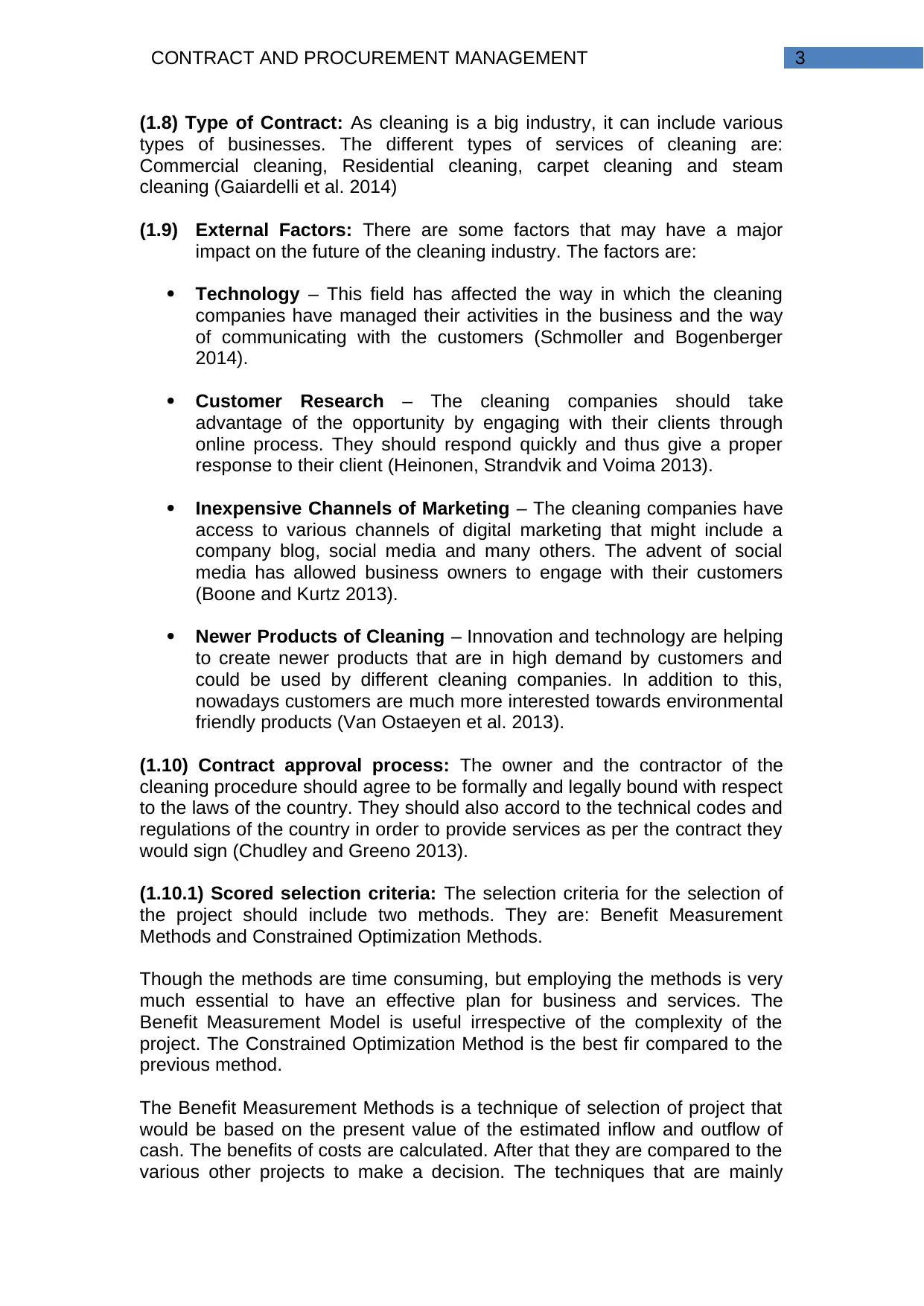
3CONTRACT AND PROCUREMENT MANAGEMENT
(1.8) Type of Contract: As cleaning is a big industry, it can include various
types of businesses. The different types of services of cleaning are:
Commercial cleaning, Residential cleaning, carpet cleaning and steam
cleaning (Gaiardelli et al. 2014)
(1.9) External Factors: There are some factors that may have a major
impact on the future of the cleaning industry. The factors are:
Technology – This field has affected the way in which the cleaning
companies have managed their activities in the business and the way
of communicating with the customers (Schmoller and Bogenberger
2014).
Customer Research – The cleaning companies should take
advantage of the opportunity by engaging with their clients through
online process. They should respond quickly and thus give a proper
response to their client (Heinonen, Strandvik and Voima 2013).
Inexpensive Channels of Marketing – The cleaning companies have
access to various channels of digital marketing that might include a
company blog, social media and many others. The advent of social
media has allowed business owners to engage with their customers
(Boone and Kurtz 2013).
Newer Products of Cleaning – Innovation and technology are helping
to create newer products that are in high demand by customers and
could be used by different cleaning companies. In addition to this,
nowadays customers are much more interested towards environmental
friendly products (Van Ostaeyen et al. 2013).
(1.10) Contract approval process: The owner and the contractor of the
cleaning procedure should agree to be formally and legally bound with respect
to the laws of the country. They should also accord to the technical codes and
regulations of the country in order to provide services as per the contract they
would sign (Chudley and Greeno 2013).
(1.10.1) Scored selection criteria: The selection criteria for the selection of
the project should include two methods. They are: Benefit Measurement
Methods and Constrained Optimization Methods.
Though the methods are time consuming, but employing the methods is very
much essential to have an effective plan for business and services. The
Benefit Measurement Model is useful irrespective of the complexity of the
project. The Constrained Optimization Method is the best fir compared to the
previous method.
The Benefit Measurement Methods is a technique of selection of project that
would be based on the present value of the estimated inflow and outflow of
cash. The benefits of costs are calculated. After that they are compared to the
various other projects to make a decision. The techniques that are mainly
(1.8) Type of Contract: As cleaning is a big industry, it can include various
types of businesses. The different types of services of cleaning are:
Commercial cleaning, Residential cleaning, carpet cleaning and steam
cleaning (Gaiardelli et al. 2014)
(1.9) External Factors: There are some factors that may have a major
impact on the future of the cleaning industry. The factors are:
Technology – This field has affected the way in which the cleaning
companies have managed their activities in the business and the way
of communicating with the customers (Schmoller and Bogenberger
2014).
Customer Research – The cleaning companies should take
advantage of the opportunity by engaging with their clients through
online process. They should respond quickly and thus give a proper
response to their client (Heinonen, Strandvik and Voima 2013).
Inexpensive Channels of Marketing – The cleaning companies have
access to various channels of digital marketing that might include a
company blog, social media and many others. The advent of social
media has allowed business owners to engage with their customers
(Boone and Kurtz 2013).
Newer Products of Cleaning – Innovation and technology are helping
to create newer products that are in high demand by customers and
could be used by different cleaning companies. In addition to this,
nowadays customers are much more interested towards environmental
friendly products (Van Ostaeyen et al. 2013).
(1.10) Contract approval process: The owner and the contractor of the
cleaning procedure should agree to be formally and legally bound with respect
to the laws of the country. They should also accord to the technical codes and
regulations of the country in order to provide services as per the contract they
would sign (Chudley and Greeno 2013).
(1.10.1) Scored selection criteria: The selection criteria for the selection of
the project should include two methods. They are: Benefit Measurement
Methods and Constrained Optimization Methods.
Though the methods are time consuming, but employing the methods is very
much essential to have an effective plan for business and services. The
Benefit Measurement Model is useful irrespective of the complexity of the
project. The Constrained Optimization Method is the best fir compared to the
previous method.
The Benefit Measurement Methods is a technique of selection of project that
would be based on the present value of the estimated inflow and outflow of
cash. The benefits of costs are calculated. After that they are compared to the
various other projects to make a decision. The techniques that are mainly
Paraphrase This Document
Need a fresh take? Get an instant paraphrase of this document with our AI Paraphraser
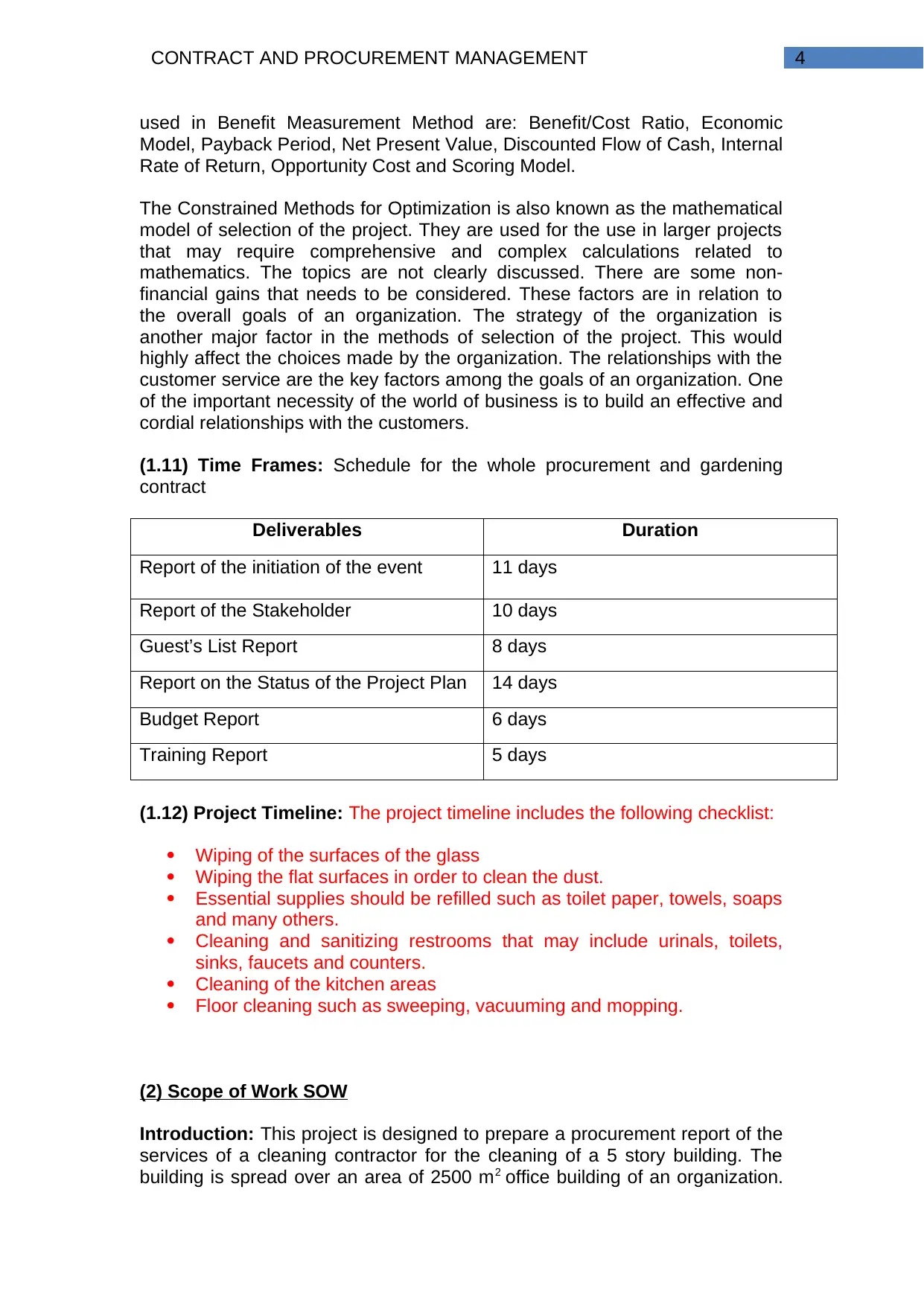
4CONTRACT AND PROCUREMENT MANAGEMENT
used in Benefit Measurement Method are: Benefit/Cost Ratio, Economic
Model, Payback Period, Net Present Value, Discounted Flow of Cash, Internal
Rate of Return, Opportunity Cost and Scoring Model.
The Constrained Methods for Optimization is also known as the mathematical
model of selection of the project. They are used for the use in larger projects
that may require comprehensive and complex calculations related to
mathematics. The topics are not clearly discussed. There are some non-
financial gains that needs to be considered. These factors are in relation to
the overall goals of an organization. The strategy of the organization is
another major factor in the methods of selection of the project. This would
highly affect the choices made by the organization. The relationships with the
customer service are the key factors among the goals of an organization. One
of the important necessity of the world of business is to build an effective and
cordial relationships with the customers.
(1.11) Time Frames: Schedule for the whole procurement and gardening
contract
Deliverables Duration
Report of the initiation of the event 11 days
Report of the Stakeholder 10 days
Guest’s List Report 8 days
Report on the Status of the Project Plan 14 days
Budget Report 6 days
Training Report 5 days
(1.12) Project Timeline: The project timeline includes the following checklist:
Wiping of the surfaces of the glass
Wiping the flat surfaces in order to clean the dust.
Essential supplies should be refilled such as toilet paper, towels, soaps
and many others.
Cleaning and sanitizing restrooms that may include urinals, toilets,
sinks, faucets and counters.
Cleaning of the kitchen areas
Floor cleaning such as sweeping, vacuuming and mopping.
(2) Scope of Work SOW
Introduction: This project is designed to prepare a procurement report of the
services of a cleaning contractor for the cleaning of a 5 story building. The
building is spread over an area of 2500 m2 office building of an organization.
used in Benefit Measurement Method are: Benefit/Cost Ratio, Economic
Model, Payback Period, Net Present Value, Discounted Flow of Cash, Internal
Rate of Return, Opportunity Cost and Scoring Model.
The Constrained Methods for Optimization is also known as the mathematical
model of selection of the project. They are used for the use in larger projects
that may require comprehensive and complex calculations related to
mathematics. The topics are not clearly discussed. There are some non-
financial gains that needs to be considered. These factors are in relation to
the overall goals of an organization. The strategy of the organization is
another major factor in the methods of selection of the project. This would
highly affect the choices made by the organization. The relationships with the
customer service are the key factors among the goals of an organization. One
of the important necessity of the world of business is to build an effective and
cordial relationships with the customers.
(1.11) Time Frames: Schedule for the whole procurement and gardening
contract
Deliverables Duration
Report of the initiation of the event 11 days
Report of the Stakeholder 10 days
Guest’s List Report 8 days
Report on the Status of the Project Plan 14 days
Budget Report 6 days
Training Report 5 days
(1.12) Project Timeline: The project timeline includes the following checklist:
Wiping of the surfaces of the glass
Wiping the flat surfaces in order to clean the dust.
Essential supplies should be refilled such as toilet paper, towels, soaps
and many others.
Cleaning and sanitizing restrooms that may include urinals, toilets,
sinks, faucets and counters.
Cleaning of the kitchen areas
Floor cleaning such as sweeping, vacuuming and mopping.
(2) Scope of Work SOW
Introduction: This project is designed to prepare a procurement report of the
services of a cleaning contractor for the cleaning of a 5 story building. The
building is spread over an area of 2500 m2 office building of an organization.
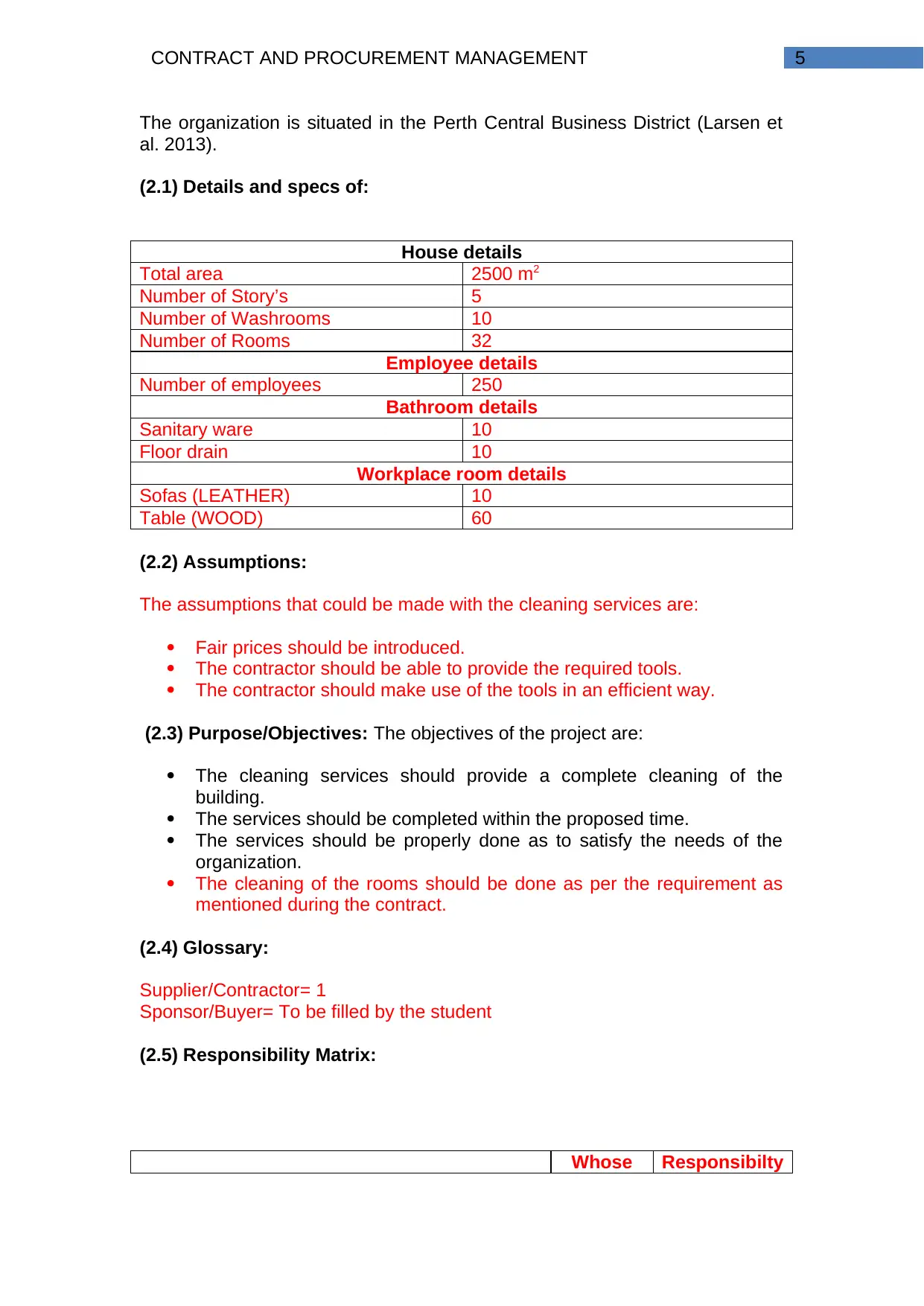
5CONTRACT AND PROCUREMENT MANAGEMENT
The organization is situated in the Perth Central Business District (Larsen et
al. 2013).
(2.1) Details and specs of:
House details
Total area 2500 m2
Number of Story’s 5
Number of Washrooms 10
Number of Rooms 32
Employee details
Number of employees 250
Bathroom details
Sanitary ware 10
Floor drain 10
Workplace room details
Sofas (LEATHER) 10
Table (WOOD) 60
(2.2) Assumptions:
The assumptions that could be made with the cleaning services are:
Fair prices should be introduced.
The contractor should be able to provide the required tools.
The contractor should make use of the tools in an efficient way.
(2.3) Purpose/Objectives: The objectives of the project are:
The cleaning services should provide a complete cleaning of the
building.
The services should be completed within the proposed time.
The services should be properly done as to satisfy the needs of the
organization.
The cleaning of the rooms should be done as per the requirement as
mentioned during the contract.
(2.4) Glossary:
Supplier/Contractor= 1
Sponsor/Buyer= To be filled by the student
(2.5) Responsibility Matrix:
Whose Responsibilty
The organization is situated in the Perth Central Business District (Larsen et
al. 2013).
(2.1) Details and specs of:
House details
Total area 2500 m2
Number of Story’s 5
Number of Washrooms 10
Number of Rooms 32
Employee details
Number of employees 250
Bathroom details
Sanitary ware 10
Floor drain 10
Workplace room details
Sofas (LEATHER) 10
Table (WOOD) 60
(2.2) Assumptions:
The assumptions that could be made with the cleaning services are:
Fair prices should be introduced.
The contractor should be able to provide the required tools.
The contractor should make use of the tools in an efficient way.
(2.3) Purpose/Objectives: The objectives of the project are:
The cleaning services should provide a complete cleaning of the
building.
The services should be completed within the proposed time.
The services should be properly done as to satisfy the needs of the
organization.
The cleaning of the rooms should be done as per the requirement as
mentioned during the contract.
(2.4) Glossary:
Supplier/Contractor= 1
Sponsor/Buyer= To be filled by the student
(2.5) Responsibility Matrix:
Whose Responsibilty
⊘ This is a preview!⊘
Do you want full access?
Subscribe today to unlock all pages.

Trusted by 1+ million students worldwide
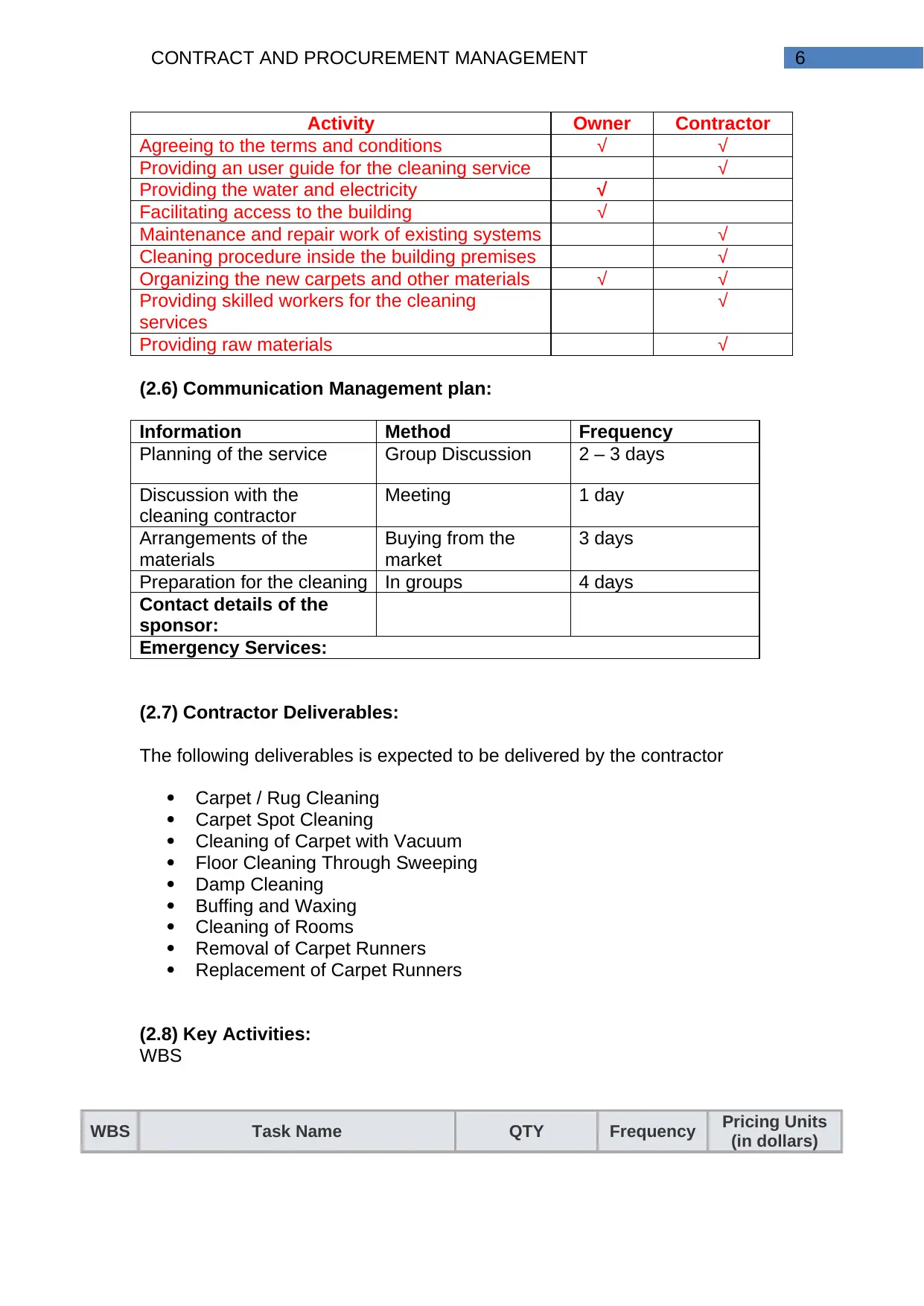
6CONTRACT AND PROCUREMENT MANAGEMENT
Activity Owner Contractor
Agreeing to the terms and conditions √ √
Providing an user guide for the cleaning service √
Providing the water and electricity √
Facilitating access to the building √
Maintenance and repair work of existing systems √
Cleaning procedure inside the building premises √
Organizing the new carpets and other materials √ √
Providing skilled workers for the cleaning
services
√
Providing raw materials √
(2.6) Communication Management plan:
Information Method Frequency
Planning of the service Group Discussion 2 – 3 days
Discussion with the
cleaning contractor
Meeting 1 day
Arrangements of the
materials
Buying from the
market
3 days
Preparation for the cleaning In groups 4 days
Contact details of the
sponsor:
Emergency Services:
(2.7) Contractor Deliverables:
The following deliverables is expected to be delivered by the contractor
Carpet / Rug Cleaning
Carpet Spot Cleaning
Cleaning of Carpet with Vacuum
Floor Cleaning Through Sweeping
Damp Cleaning
Buffing and Waxing
Cleaning of Rooms
Removal of Carpet Runners
Replacement of Carpet Runners
(2.8) Key Activities:
WBS
WBS Task Name QTY Frequency Pricing Units
(in dollars)
Activity Owner Contractor
Agreeing to the terms and conditions √ √
Providing an user guide for the cleaning service √
Providing the water and electricity √
Facilitating access to the building √
Maintenance and repair work of existing systems √
Cleaning procedure inside the building premises √
Organizing the new carpets and other materials √ √
Providing skilled workers for the cleaning
services
√
Providing raw materials √
(2.6) Communication Management plan:
Information Method Frequency
Planning of the service Group Discussion 2 – 3 days
Discussion with the
cleaning contractor
Meeting 1 day
Arrangements of the
materials
Buying from the
market
3 days
Preparation for the cleaning In groups 4 days
Contact details of the
sponsor:
Emergency Services:
(2.7) Contractor Deliverables:
The following deliverables is expected to be delivered by the contractor
Carpet / Rug Cleaning
Carpet Spot Cleaning
Cleaning of Carpet with Vacuum
Floor Cleaning Through Sweeping
Damp Cleaning
Buffing and Waxing
Cleaning of Rooms
Removal of Carpet Runners
Replacement of Carpet Runners
(2.8) Key Activities:
WBS
WBS Task Name QTY Frequency Pricing Units
(in dollars)
Paraphrase This Document
Need a fresh take? Get an instant paraphrase of this document with our AI Paraphraser
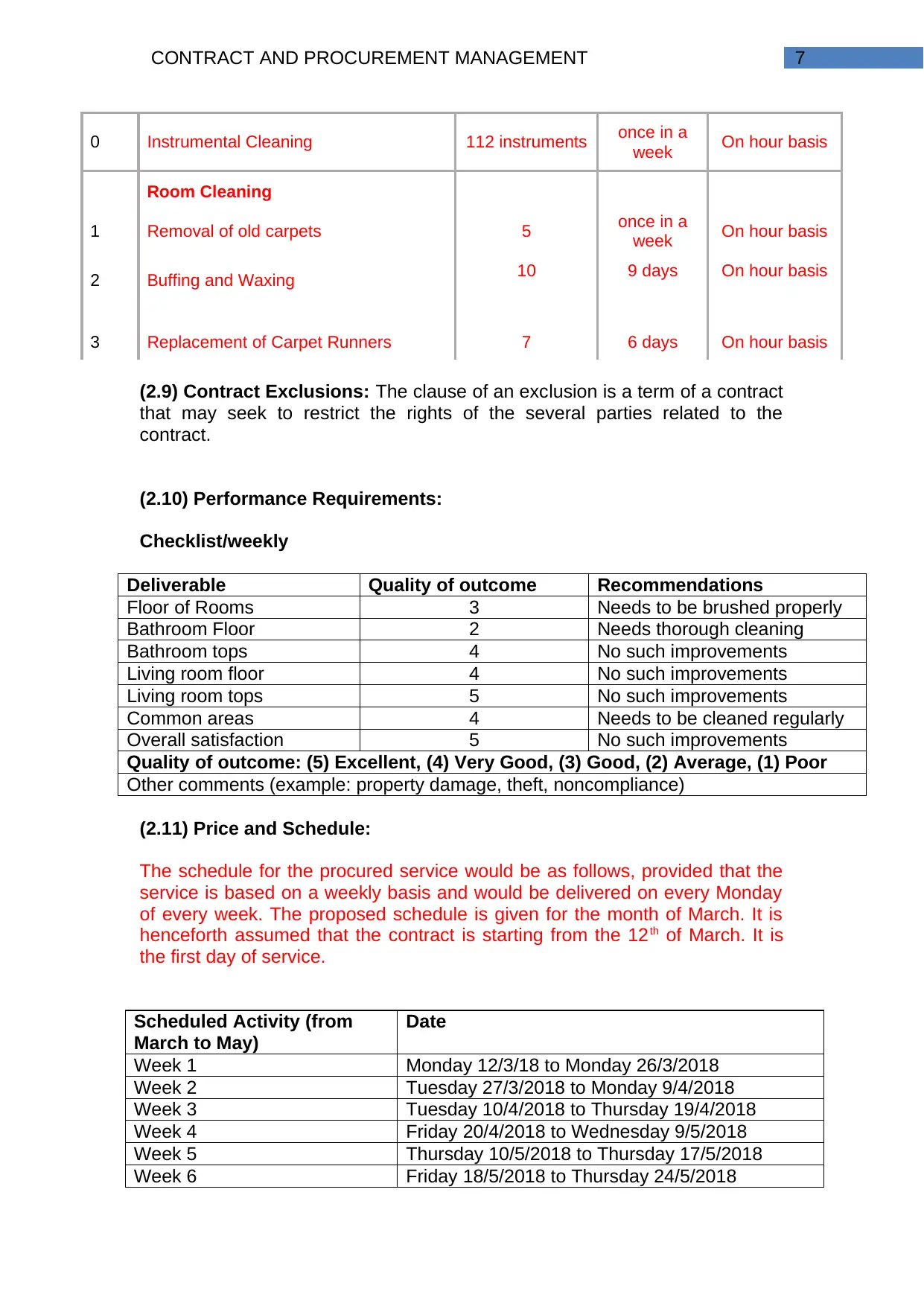
7CONTRACT AND PROCUREMENT MANAGEMENT
0 Instrumental Cleaning 112 instruments once in a
week On hour basis
1
Room Cleaning
Removal of old carpets 5 once in a
week On hour basis
2 Buffing and Waxing 10 9 days On hour basis
3 Replacement of Carpet Runners 7 6 days On hour basis
(2.9) Contract Exclusions: The clause of an exclusion is a term of a contract
that may seek to restrict the rights of the several parties related to the
contract.
(2.10) Performance Requirements:
Checklist/weekly
Deliverable Quality of outcome Recommendations
Floor of Rooms 3 Needs to be brushed properly
Bathroom Floor 2 Needs thorough cleaning
Bathroom tops 4 No such improvements
Living room floor 4 No such improvements
Living room tops 5 No such improvements
Common areas 4 Needs to be cleaned regularly
Overall satisfaction 5 No such improvements
Quality of outcome: (5) Excellent, (4) Very Good, (3) Good, (2) Average, (1) Poor
Other comments (example: property damage, theft, noncompliance)
(2.11) Price and Schedule:
The schedule for the procured service would be as follows, provided that the
service is based on a weekly basis and would be delivered on every Monday
of every week. The proposed schedule is given for the month of March. It is
henceforth assumed that the contract is starting from the 12th of March. It is
the first day of service.
Scheduled Activity (from
March to May)
Date
Week 1 Monday 12/3/18 to Monday 26/3/2018
Week 2 Tuesday 27/3/2018 to Monday 9/4/2018
Week 3 Tuesday 10/4/2018 to Thursday 19/4/2018
Week 4 Friday 20/4/2018 to Wednesday 9/5/2018
Week 5 Thursday 10/5/2018 to Thursday 17/5/2018
Week 6 Friday 18/5/2018 to Thursday 24/5/2018
0 Instrumental Cleaning 112 instruments once in a
week On hour basis
1
Room Cleaning
Removal of old carpets 5 once in a
week On hour basis
2 Buffing and Waxing 10 9 days On hour basis
3 Replacement of Carpet Runners 7 6 days On hour basis
(2.9) Contract Exclusions: The clause of an exclusion is a term of a contract
that may seek to restrict the rights of the several parties related to the
contract.
(2.10) Performance Requirements:
Checklist/weekly
Deliverable Quality of outcome Recommendations
Floor of Rooms 3 Needs to be brushed properly
Bathroom Floor 2 Needs thorough cleaning
Bathroom tops 4 No such improvements
Living room floor 4 No such improvements
Living room tops 5 No such improvements
Common areas 4 Needs to be cleaned regularly
Overall satisfaction 5 No such improvements
Quality of outcome: (5) Excellent, (4) Very Good, (3) Good, (2) Average, (1) Poor
Other comments (example: property damage, theft, noncompliance)
(2.11) Price and Schedule:
The schedule for the procured service would be as follows, provided that the
service is based on a weekly basis and would be delivered on every Monday
of every week. The proposed schedule is given for the month of March. It is
henceforth assumed that the contract is starting from the 12th of March. It is
the first day of service.
Scheduled Activity (from
March to May)
Date
Week 1 Monday 12/3/18 to Monday 26/3/2018
Week 2 Tuesday 27/3/2018 to Monday 9/4/2018
Week 3 Tuesday 10/4/2018 to Thursday 19/4/2018
Week 4 Friday 20/4/2018 to Wednesday 9/5/2018
Week 5 Thursday 10/5/2018 to Thursday 17/5/2018
Week 6 Friday 18/5/2018 to Thursday 24/5/2018
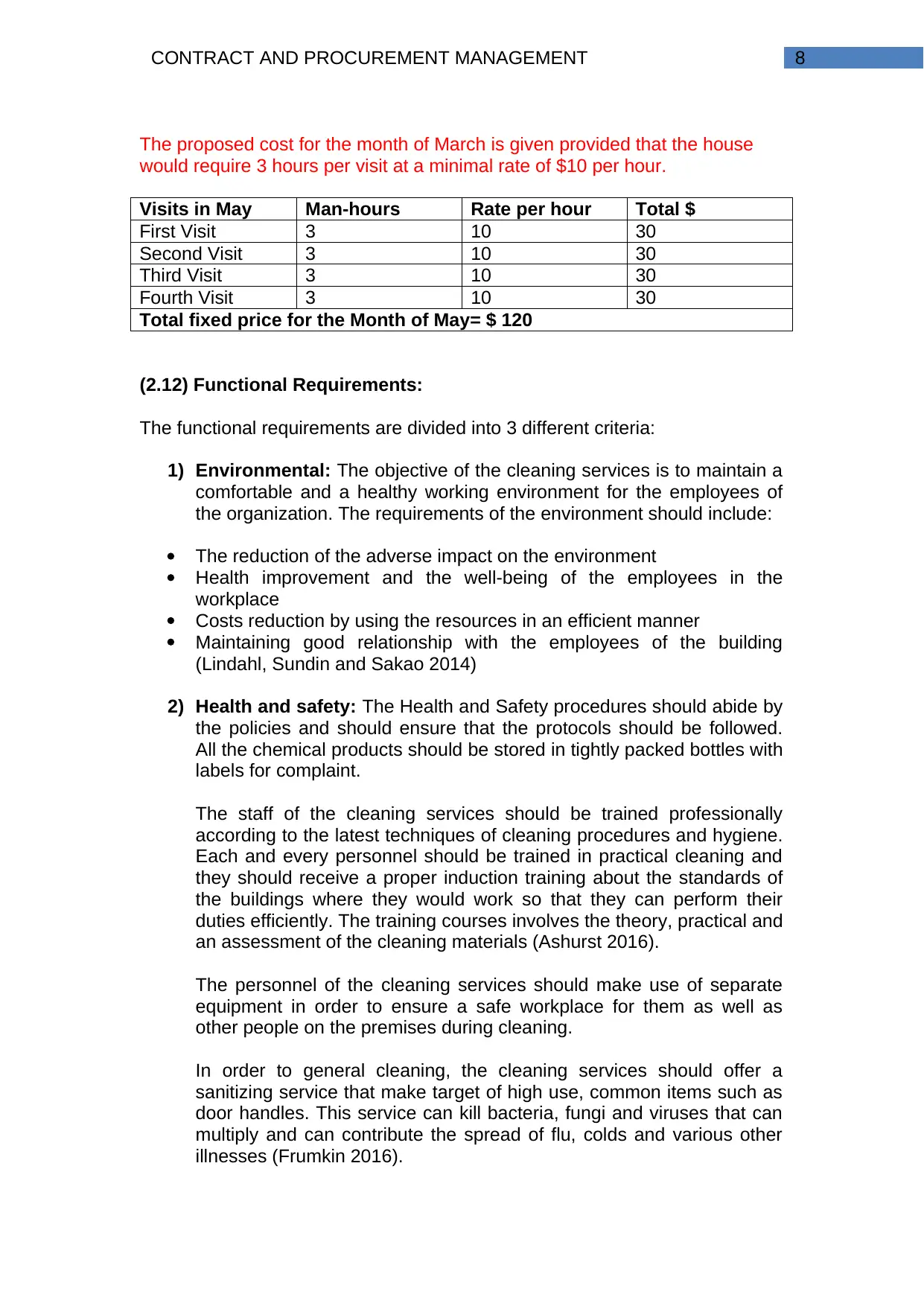
8CONTRACT AND PROCUREMENT MANAGEMENT
The proposed cost for the month of March is given provided that the house
would require 3 hours per visit at a minimal rate of $10 per hour.
Visits in May Man-hours Rate per hour Total $
First Visit 3 10 30
Second Visit 3 10 30
Third Visit 3 10 30
Fourth Visit 3 10 30
Total fixed price for the Month of May= $ 120
(2.12) Functional Requirements:
The functional requirements are divided into 3 different criteria:
1) Environmental: The objective of the cleaning services is to maintain a
comfortable and a healthy working environment for the employees of
the organization. The requirements of the environment should include:
The reduction of the adverse impact on the environment
Health improvement and the well-being of the employees in the
workplace
Costs reduction by using the resources in an efficient manner
Maintaining good relationship with the employees of the building
(Lindahl, Sundin and Sakao 2014)
2) Health and safety: The Health and Safety procedures should abide by
the policies and should ensure that the protocols should be followed.
All the chemical products should be stored in tightly packed bottles with
labels for complaint.
The staff of the cleaning services should be trained professionally
according to the latest techniques of cleaning procedures and hygiene.
Each and every personnel should be trained in practical cleaning and
they should receive a proper induction training about the standards of
the buildings where they would work so that they can perform their
duties efficiently. The training courses involves the theory, practical and
an assessment of the cleaning materials (Ashurst 2016).
The personnel of the cleaning services should make use of separate
equipment in order to ensure a safe workplace for them as well as
other people on the premises during cleaning.
In order to general cleaning, the cleaning services should offer a
sanitizing service that make target of high use, common items such as
door handles. This service can kill bacteria, fungi and viruses that can
multiply and can contribute the spread of flu, colds and various other
illnesses (Frumkin 2016).
The proposed cost for the month of March is given provided that the house
would require 3 hours per visit at a minimal rate of $10 per hour.
Visits in May Man-hours Rate per hour Total $
First Visit 3 10 30
Second Visit 3 10 30
Third Visit 3 10 30
Fourth Visit 3 10 30
Total fixed price for the Month of May= $ 120
(2.12) Functional Requirements:
The functional requirements are divided into 3 different criteria:
1) Environmental: The objective of the cleaning services is to maintain a
comfortable and a healthy working environment for the employees of
the organization. The requirements of the environment should include:
The reduction of the adverse impact on the environment
Health improvement and the well-being of the employees in the
workplace
Costs reduction by using the resources in an efficient manner
Maintaining good relationship with the employees of the building
(Lindahl, Sundin and Sakao 2014)
2) Health and safety: The Health and Safety procedures should abide by
the policies and should ensure that the protocols should be followed.
All the chemical products should be stored in tightly packed bottles with
labels for complaint.
The staff of the cleaning services should be trained professionally
according to the latest techniques of cleaning procedures and hygiene.
Each and every personnel should be trained in practical cleaning and
they should receive a proper induction training about the standards of
the buildings where they would work so that they can perform their
duties efficiently. The training courses involves the theory, practical and
an assessment of the cleaning materials (Ashurst 2016).
The personnel of the cleaning services should make use of separate
equipment in order to ensure a safe workplace for them as well as
other people on the premises during cleaning.
In order to general cleaning, the cleaning services should offer a
sanitizing service that make target of high use, common items such as
door handles. This service can kill bacteria, fungi and viruses that can
multiply and can contribute the spread of flu, colds and various other
illnesses (Frumkin 2016).
⊘ This is a preview!⊘
Do you want full access?
Subscribe today to unlock all pages.

Trusted by 1+ million students worldwide
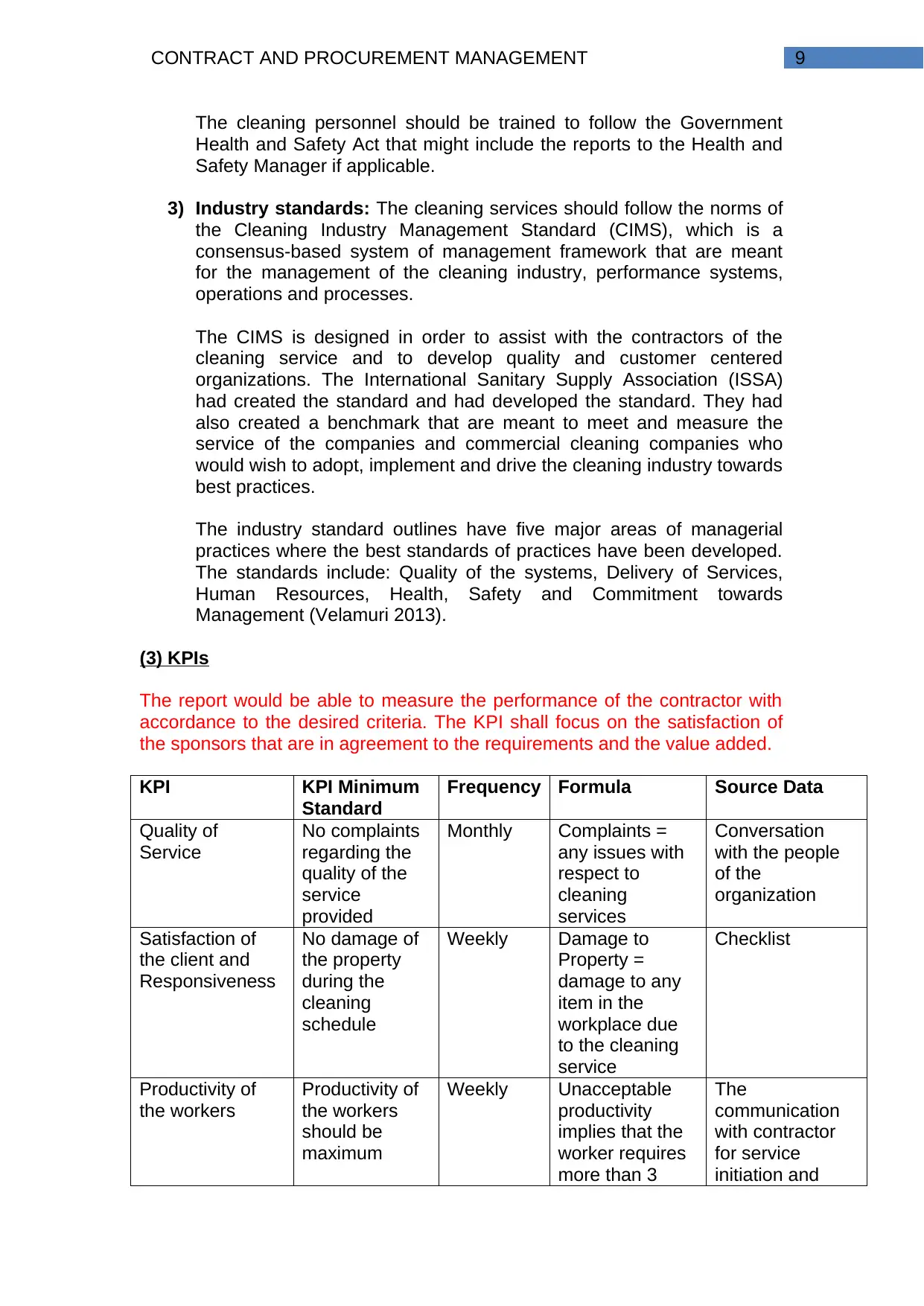
9CONTRACT AND PROCUREMENT MANAGEMENT
The cleaning personnel should be trained to follow the Government
Health and Safety Act that might include the reports to the Health and
Safety Manager if applicable.
3) Industry standards: The cleaning services should follow the norms of
the Cleaning Industry Management Standard (CIMS), which is a
consensus-based system of management framework that are meant
for the management of the cleaning industry, performance systems,
operations and processes.
The CIMS is designed in order to assist with the contractors of the
cleaning service and to develop quality and customer centered
organizations. The International Sanitary Supply Association (ISSA)
had created the standard and had developed the standard. They had
also created a benchmark that are meant to meet and measure the
service of the companies and commercial cleaning companies who
would wish to adopt, implement and drive the cleaning industry towards
best practices.
The industry standard outlines have five major areas of managerial
practices where the best standards of practices have been developed.
The standards include: Quality of the systems, Delivery of Services,
Human Resources, Health, Safety and Commitment towards
Management (Velamuri 2013).
(3) KPIs
The report would be able to measure the performance of the contractor with
accordance to the desired criteria. The KPI shall focus on the satisfaction of
the sponsors that are in agreement to the requirements and the value added.
KPI KPI Minimum
Standard
Frequency Formula Source Data
Quality of
Service
No complaints
regarding the
quality of the
service
provided
Monthly Complaints =
any issues with
respect to
cleaning
services
Conversation
with the people
of the
organization
Satisfaction of
the client and
Responsiveness
No damage of
the property
during the
cleaning
schedule
Weekly Damage to
Property =
damage to any
item in the
workplace due
to the cleaning
service
Checklist
Productivity of
the workers
Productivity of
the workers
should be
maximum
Weekly Unacceptable
productivity
implies that the
worker requires
more than 3
The
communication
with contractor
for service
initiation and
The cleaning personnel should be trained to follow the Government
Health and Safety Act that might include the reports to the Health and
Safety Manager if applicable.
3) Industry standards: The cleaning services should follow the norms of
the Cleaning Industry Management Standard (CIMS), which is a
consensus-based system of management framework that are meant
for the management of the cleaning industry, performance systems,
operations and processes.
The CIMS is designed in order to assist with the contractors of the
cleaning service and to develop quality and customer centered
organizations. The International Sanitary Supply Association (ISSA)
had created the standard and had developed the standard. They had
also created a benchmark that are meant to meet and measure the
service of the companies and commercial cleaning companies who
would wish to adopt, implement and drive the cleaning industry towards
best practices.
The industry standard outlines have five major areas of managerial
practices where the best standards of practices have been developed.
The standards include: Quality of the systems, Delivery of Services,
Human Resources, Health, Safety and Commitment towards
Management (Velamuri 2013).
(3) KPIs
The report would be able to measure the performance of the contractor with
accordance to the desired criteria. The KPI shall focus on the satisfaction of
the sponsors that are in agreement to the requirements and the value added.
KPI KPI Minimum
Standard
Frequency Formula Source Data
Quality of
Service
No complaints
regarding the
quality of the
service
provided
Monthly Complaints =
any issues with
respect to
cleaning
services
Conversation
with the people
of the
organization
Satisfaction of
the client and
Responsiveness
No damage of
the property
during the
cleaning
schedule
Weekly Damage to
Property =
damage to any
item in the
workplace due
to the cleaning
service
Checklist
Productivity of
the workers
Productivity of
the workers
should be
maximum
Weekly Unacceptable
productivity
implies that the
worker requires
more than 3
The
communication
with contractor
for service
initiation and
Paraphrase This Document
Need a fresh take? Get an instant paraphrase of this document with our AI Paraphraser
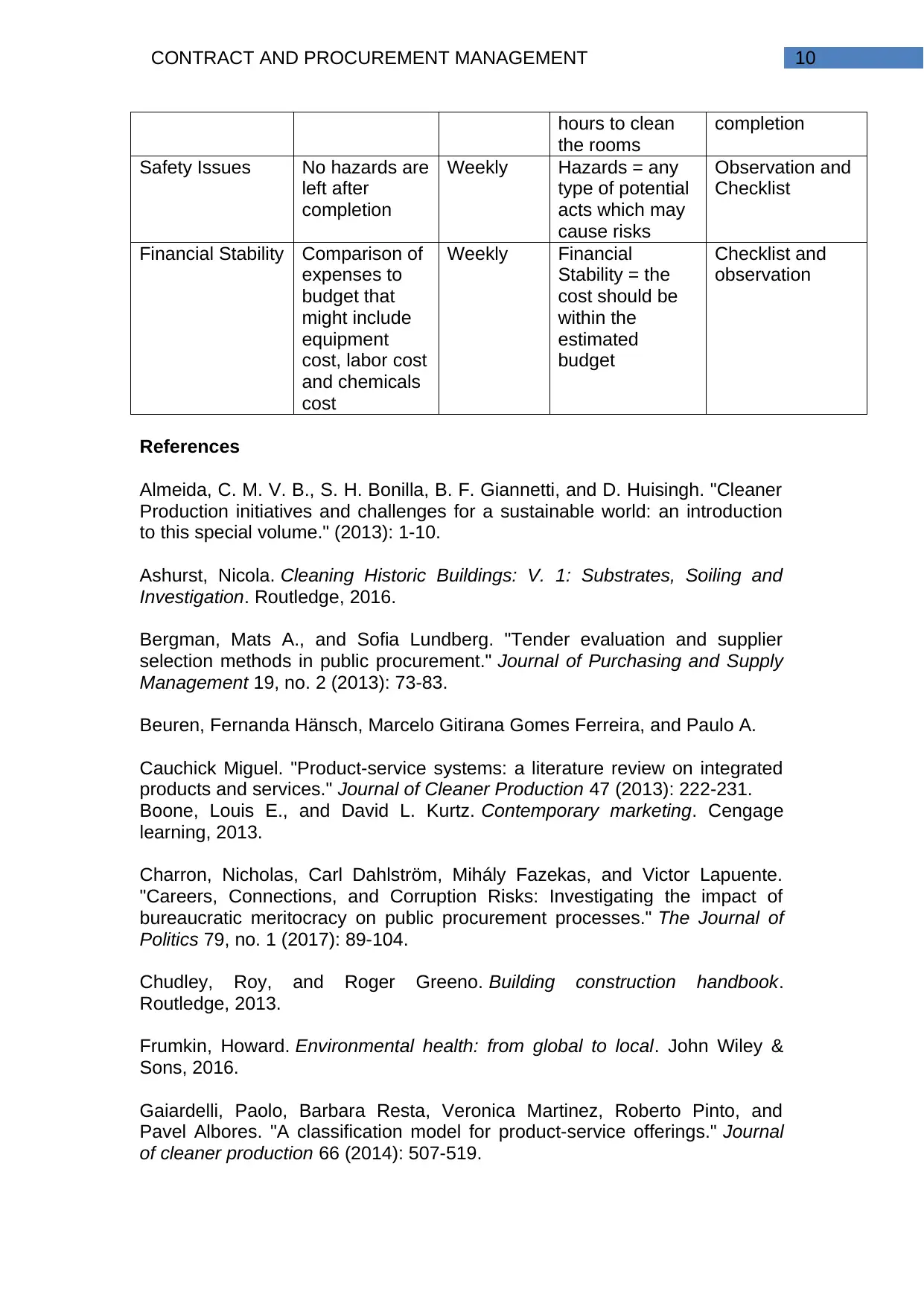
10CONTRACT AND PROCUREMENT MANAGEMENT
hours to clean
the rooms
completion
Safety Issues No hazards are
left after
completion
Weekly Hazards = any
type of potential
acts which may
cause risks
Observation and
Checklist
Financial Stability Comparison of
expenses to
budget that
might include
equipment
cost, labor cost
and chemicals
cost
Weekly Financial
Stability = the
cost should be
within the
estimated
budget
Checklist and
observation
References
Almeida, C. M. V. B., S. H. Bonilla, B. F. Giannetti, and D. Huisingh. "Cleaner
Production initiatives and challenges for a sustainable world: an introduction
to this special volume." (2013): 1-10.
Ashurst, Nicola. Cleaning Historic Buildings: V. 1: Substrates, Soiling and
Investigation. Routledge, 2016.
Bergman, Mats A., and Sofia Lundberg. "Tender evaluation and supplier
selection methods in public procurement." Journal of Purchasing and Supply
Management 19, no. 2 (2013): 73-83.
Beuren, Fernanda Hänsch, Marcelo Gitirana Gomes Ferreira, and Paulo A.
Cauchick Miguel. "Product-service systems: a literature review on integrated
products and services." Journal of Cleaner Production 47 (2013): 222-231.
Boone, Louis E., and David L. Kurtz. Contemporary marketing. Cengage
learning, 2013.
Charron, Nicholas, Carl Dahlström, Mihály Fazekas, and Victor Lapuente.
"Careers, Connections, and Corruption Risks: Investigating the impact of
bureaucratic meritocracy on public procurement processes." The Journal of
Politics 79, no. 1 (2017): 89-104.
Chudley, Roy, and Roger Greeno. Building construction handbook.
Routledge, 2013.
Frumkin, Howard. Environmental health: from global to local. John Wiley &
Sons, 2016.
Gaiardelli, Paolo, Barbara Resta, Veronica Martinez, Roberto Pinto, and
Pavel Albores. "A classification model for product-service offerings." Journal
of cleaner production 66 (2014): 507-519.
hours to clean
the rooms
completion
Safety Issues No hazards are
left after
completion
Weekly Hazards = any
type of potential
acts which may
cause risks
Observation and
Checklist
Financial Stability Comparison of
expenses to
budget that
might include
equipment
cost, labor cost
and chemicals
cost
Weekly Financial
Stability = the
cost should be
within the
estimated
budget
Checklist and
observation
References
Almeida, C. M. V. B., S. H. Bonilla, B. F. Giannetti, and D. Huisingh. "Cleaner
Production initiatives and challenges for a sustainable world: an introduction
to this special volume." (2013): 1-10.
Ashurst, Nicola. Cleaning Historic Buildings: V. 1: Substrates, Soiling and
Investigation. Routledge, 2016.
Bergman, Mats A., and Sofia Lundberg. "Tender evaluation and supplier
selection methods in public procurement." Journal of Purchasing and Supply
Management 19, no. 2 (2013): 73-83.
Beuren, Fernanda Hänsch, Marcelo Gitirana Gomes Ferreira, and Paulo A.
Cauchick Miguel. "Product-service systems: a literature review on integrated
products and services." Journal of Cleaner Production 47 (2013): 222-231.
Boone, Louis E., and David L. Kurtz. Contemporary marketing. Cengage
learning, 2013.
Charron, Nicholas, Carl Dahlström, Mihály Fazekas, and Victor Lapuente.
"Careers, Connections, and Corruption Risks: Investigating the impact of
bureaucratic meritocracy on public procurement processes." The Journal of
Politics 79, no. 1 (2017): 89-104.
Chudley, Roy, and Roger Greeno. Building construction handbook.
Routledge, 2013.
Frumkin, Howard. Environmental health: from global to local. John Wiley &
Sons, 2016.
Gaiardelli, Paolo, Barbara Resta, Veronica Martinez, Roberto Pinto, and
Pavel Albores. "A classification model for product-service offerings." Journal
of cleaner production 66 (2014): 507-519.
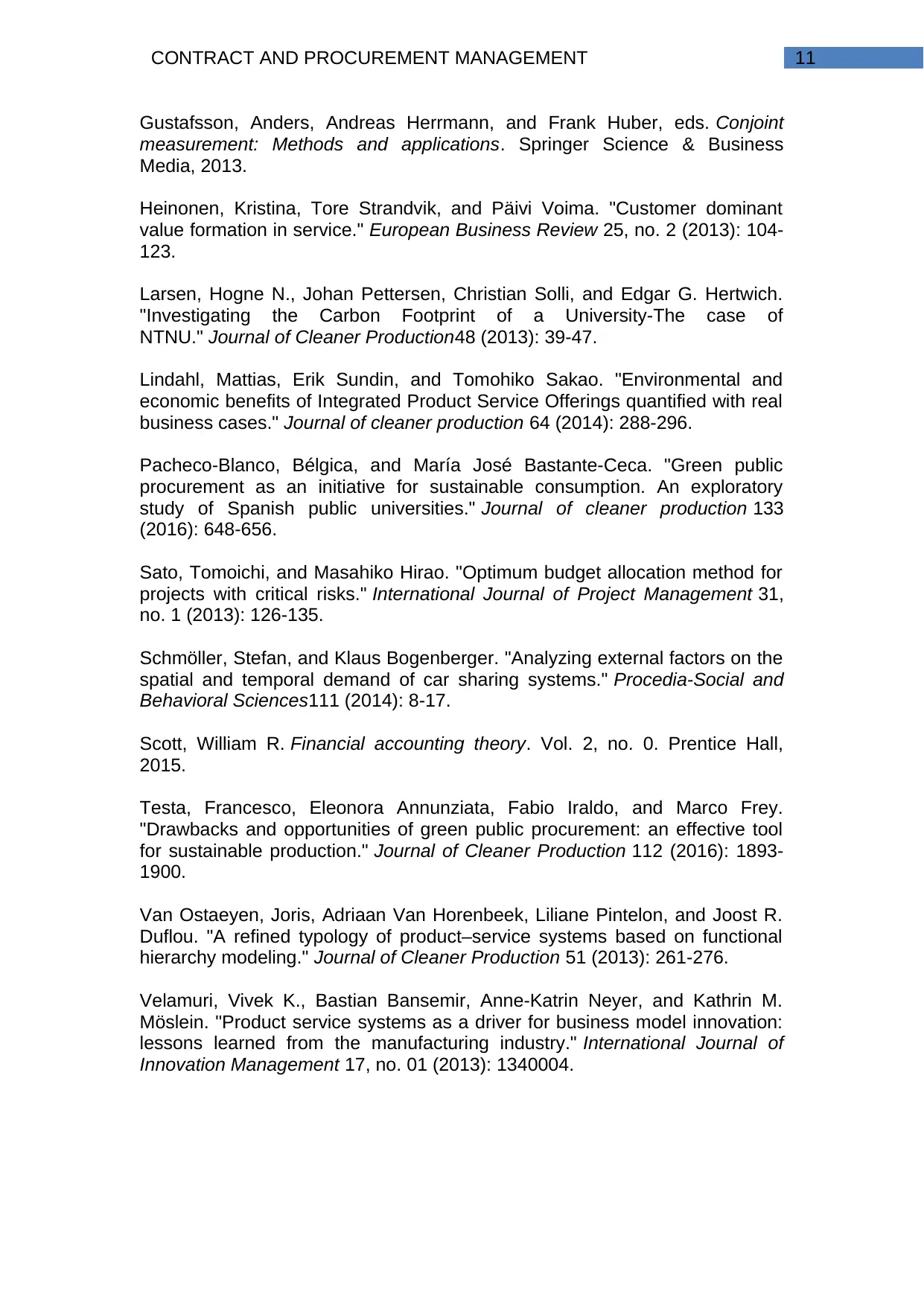
11CONTRACT AND PROCUREMENT MANAGEMENT
Gustafsson, Anders, Andreas Herrmann, and Frank Huber, eds. Conjoint
measurement: Methods and applications. Springer Science & Business
Media, 2013.
Heinonen, Kristina, Tore Strandvik, and Päivi Voima. "Customer dominant
value formation in service." European Business Review 25, no. 2 (2013): 104-
123.
Larsen, Hogne N., Johan Pettersen, Christian Solli, and Edgar G. Hertwich.
"Investigating the Carbon Footprint of a University-The case of
NTNU." Journal of Cleaner Production48 (2013): 39-47.
Lindahl, Mattias, Erik Sundin, and Tomohiko Sakao. "Environmental and
economic benefits of Integrated Product Service Offerings quantified with real
business cases." Journal of cleaner production 64 (2014): 288-296.
Pacheco-Blanco, Bélgica, and María José Bastante-Ceca. "Green public
procurement as an initiative for sustainable consumption. An exploratory
study of Spanish public universities." Journal of cleaner production 133
(2016): 648-656.
Sato, Tomoichi, and Masahiko Hirao. "Optimum budget allocation method for
projects with critical risks." International Journal of Project Management 31,
no. 1 (2013): 126-135.
Schmöller, Stefan, and Klaus Bogenberger. "Analyzing external factors on the
spatial and temporal demand of car sharing systems." Procedia-Social and
Behavioral Sciences111 (2014): 8-17.
Scott, William R. Financial accounting theory. Vol. 2, no. 0. Prentice Hall,
2015.
Testa, Francesco, Eleonora Annunziata, Fabio Iraldo, and Marco Frey.
"Drawbacks and opportunities of green public procurement: an effective tool
for sustainable production." Journal of Cleaner Production 112 (2016): 1893-
1900.
Van Ostaeyen, Joris, Adriaan Van Horenbeek, Liliane Pintelon, and Joost R.
Duflou. "A refined typology of product–service systems based on functional
hierarchy modeling." Journal of Cleaner Production 51 (2013): 261-276.
Velamuri, Vivek K., Bastian Bansemir, Anne-Katrin Neyer, and Kathrin M.
Möslein. "Product service systems as a driver for business model innovation:
lessons learned from the manufacturing industry." International Journal of
Innovation Management 17, no. 01 (2013): 1340004.
Gustafsson, Anders, Andreas Herrmann, and Frank Huber, eds. Conjoint
measurement: Methods and applications. Springer Science & Business
Media, 2013.
Heinonen, Kristina, Tore Strandvik, and Päivi Voima. "Customer dominant
value formation in service." European Business Review 25, no. 2 (2013): 104-
123.
Larsen, Hogne N., Johan Pettersen, Christian Solli, and Edgar G. Hertwich.
"Investigating the Carbon Footprint of a University-The case of
NTNU." Journal of Cleaner Production48 (2013): 39-47.
Lindahl, Mattias, Erik Sundin, and Tomohiko Sakao. "Environmental and
economic benefits of Integrated Product Service Offerings quantified with real
business cases." Journal of cleaner production 64 (2014): 288-296.
Pacheco-Blanco, Bélgica, and María José Bastante-Ceca. "Green public
procurement as an initiative for sustainable consumption. An exploratory
study of Spanish public universities." Journal of cleaner production 133
(2016): 648-656.
Sato, Tomoichi, and Masahiko Hirao. "Optimum budget allocation method for
projects with critical risks." International Journal of Project Management 31,
no. 1 (2013): 126-135.
Schmöller, Stefan, and Klaus Bogenberger. "Analyzing external factors on the
spatial and temporal demand of car sharing systems." Procedia-Social and
Behavioral Sciences111 (2014): 8-17.
Scott, William R. Financial accounting theory. Vol. 2, no. 0. Prentice Hall,
2015.
Testa, Francesco, Eleonora Annunziata, Fabio Iraldo, and Marco Frey.
"Drawbacks and opportunities of green public procurement: an effective tool
for sustainable production." Journal of Cleaner Production 112 (2016): 1893-
1900.
Van Ostaeyen, Joris, Adriaan Van Horenbeek, Liliane Pintelon, and Joost R.
Duflou. "A refined typology of product–service systems based on functional
hierarchy modeling." Journal of Cleaner Production 51 (2013): 261-276.
Velamuri, Vivek K., Bastian Bansemir, Anne-Katrin Neyer, and Kathrin M.
Möslein. "Product service systems as a driver for business model innovation:
lessons learned from the manufacturing industry." International Journal of
Innovation Management 17, no. 01 (2013): 1340004.
⊘ This is a preview!⊘
Do you want full access?
Subscribe today to unlock all pages.

Trusted by 1+ million students worldwide
1 out of 13
Related Documents
Your All-in-One AI-Powered Toolkit for Academic Success.
+13062052269
info@desklib.com
Available 24*7 on WhatsApp / Email
![[object Object]](/_next/static/media/star-bottom.7253800d.svg)
Unlock your academic potential
Copyright © 2020–2025 A2Z Services. All Rights Reserved. Developed and managed by ZUCOL.




